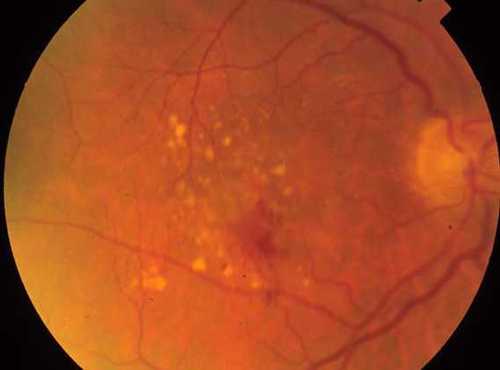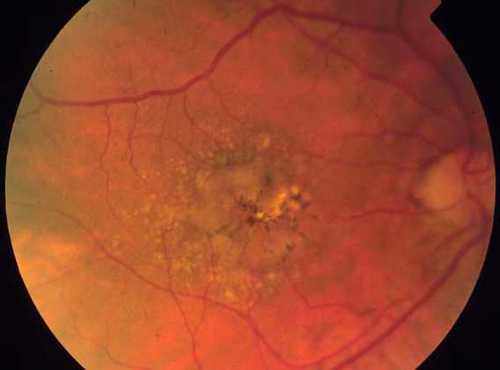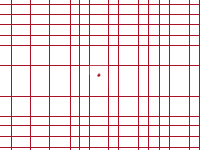|
|
 |
 |
 |
 |
|
|
Macular Degeneration
|
Printer Friendly
|



Johanna M. Seddon, MD Massachusetts Eye and Ear Infirmary, Harvard Medical School October 1, 2012
|
What Is Macular Degeneration?
Age-related macular degeneration (AMD) is the most common cause of irreversible vision loss in Americans over the age of 60. It is estimated that 10 million Americans will experience this age-related visual impairment during their retirement years.
Macular degeneration is a disorder of the retina, the light-sensitive inner lining of the back of the eye. The macula is a small, central portion of the retina which is necessary for sharp, "straight ahead" vision needed for reading, driving a car or recognizing faces.
There are a number of abnormalities associated with the term "age-related macular degeneration." They range FROM mild changes with no decrease in vision to abnormalities severe enough to result in the loss of all "straight ahead" vision. Macular degeneration does not cause total blindness because the remaining and undamaged parts of the retina around the macula continue to provide "side" vision.
There are two main types of macular degeneration, "dry" and "wet," which are discussed in the next section.
Signs and Symptoms
Aging causes the cells in the retina to become less efficient. Ultimately, deposits called drusen appear under the retina and can be seen during an eye examination and on photographs of the retina. A few small drusen may cause no decrease in vision. However, if many large drusen develop, vision may be decreased. Vision may be affected when there are pigment disturbances in the layer of cells called the retinal pigment epithelium. These two types of changes in the macula are known as "dry" macular degeneration, which is the most common form. Currently, there is no known treatment for dry AMD.
Figure 1 Figure 2 Figure 3
A few people experience the "wet" form of macular degeneration which can cause more severe visual loss. In this situation, abnormal blood vessels grow beneath the retina and result in bleeding and leakage of fluid. Vision may suddenly become distorted or blurred. In some cases of wet macular degeneration, laser treatment can be effective at destroying the abnormal vessels, thus preventing or slowing further visual loss. Wet macular degeneration cannot always be treated successfully by laser, however, some experimental drugs and surgical procedures are being tested.
A Self Test
The Amsler Grid is used to screen for macular degeneration. In an effort to detect loss of vision associated with macular degeneration, eye doctors across the country are recommending this test to their patients. The test involves looking at a square grid with a dot in the center. The grid should be held 12 inches away FROM the face. While wearing eye glasses normally worn when reading, the individual covers one eye at a time. With the uncovered eye, the individual stares at the dot in the center of the grid. All four corners of the grid should be visible, and the lines of the grid should appear to be straight and continuous FROM top to bottom and side to side. If there appear to be any holes or blurry spots, or the lines look wavy, fuzzy, crooked, distorted or broken, the individual should call their eye doctor immediately.
Eye Examinations
Today's advances in medicine means that more and more older Americans will be able to maintain good vision as they age. Since many serious eye conditions are treatable when detected at an early age, it is important to have periodic eye examinations, especially as one approaches the sixth decade of life.
How you can help to find a cure for Macular Degeneration
Unfortunately, not enough is known about macular degeneration at this time to provide effective treatment in most cases. Research today may help find the cures of tommorow. Below are listed two ongoing studies which are currently recruiting patients with macular degeneration.
Progression of Age-Related Macular Degeneration Study
Little is known about why some patients develop the advanced stages of AMD and why some lose vision. Another program conducted at the Massachusetts Eye and Ear Infirmary seeks to find out who is at high risk for these problems and why. Ultimately, researchers hope to find ways to treat AMD effectively in its early stages.
Prospective participants in this study must:
1) have macular degeneration;
2) have some central vision remaining in one eye; and
3) be between 40 and 85 years of age and be in good health.
Participants will receive one eye exam per year as part of their regular eye care for AMD, as well as special vision tests to monitor closely the progression of AMD. They will also be given the latest information about the treatment of this condition.
Johanna M. Seddon, M.D., Assoicate Professor of Ophthalmology and retina specialist at the Massachusetts Eye and Ear Infirmary, is the program director. For more information, contact the study coordinator, (617) 573-4013, or Dr. Seddon, (617) 573-4010.
FAMILY GENETIC STUDY OF AGE-RELATED MACULAR DEGENERATION
The Massachusetts Eye & Ear Infirmary and Harvard Medical School, Boston, MA, USA with the generous support of the National Eye Institute of the National Institutes of Health, need volunteers for a research study INTO the causes of age-related macular degeneration (AMD).
There is evidence that AMD runs in families. However, the exact nature of this familial tendency has not been clarified. The goal of this study is to determine whether there is an underlying gene or genes that predispose people to develop AMD. These genes will also be identified.
In this new project, researchers hope to discover how to identify people at risk of developing AMD and to explore new ways of preventing the disorder. Families are needed to participate in this study. Participants can be seen by an ophthalmologist near their home and do not need to travel to Boston.
Persons who are eligible for this study include:
People with advanced AMD (with some vision loss due to AMD) who also have two or more living siblings with the same advanced form of the disease, or who have multiple living family members who also have this eye disease.
For more information about the study, patients or their families and/or physicians can call Ilene Burton at the Massachusetts Eye and Ear Infirmary in Boston at (617) 573-4010. You may also call the office of Dr. Seddon, the prinicpal investigator at (617) 573-4010.
To enroll in study by the internet please click on ENROLL. You may also send questions regarding the study by e-mail, to Ilene at Ilene_burton@meei.harvard.edu. | |
 Figure 1
Figure 1
Figures 1-3. These photographs SHOW different degrees of dry macular degeneration. The macular degeneration increases in severity FROM top to bottom.
|
|
 Figure 2
Figure 2
|
|
 Figure 3
Figure 3
|
|
 The Amsler Grid
The Amsler Grid
A useful test of central vision. This grid may be printed and used for self screening.
|
|
| References | 1) Seddon JM, Ajani UA, Braxton MD. Familial Aggregation of Age-related Maculopathy. Am J of Ophthalmol 123:2 (1997)
2) Seddon JM, Willet WC, Speizer FE et al. A prospective study of cigarette smoking and age-related macular degeneration in women. J Am Med Assoc 276:14 (1996)
3) Bernstein PS, Seddon JM. Decision-making in the treatment of subfoveal neovascularization in age-related macular degeneration. Retina 16:2 (1996)
4) Seddon JM, Ajani UA, Sperduto, RD et al. Dietary carotenoids, vitamins A, C, and E, and advanced age-related macular degeneration. J Am Med Assoc 272:18 (1994) | | |
The information and recommendations appearing on these pages
are informational only and is not intended to be a basis for diagnosis, treatment
or any other clinical application. For specific information concerning your personal
medical condition, the DJO suggests that you consult your physician.
|
|
 |
 |
 |

|
|
 Welcome, please sign in
Welcome, please sign in  Welcome, please sign in
Welcome, please sign in